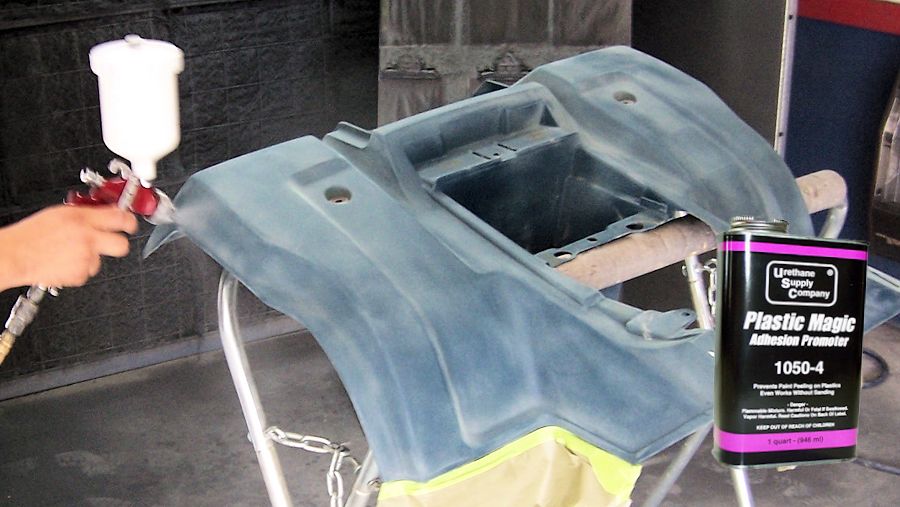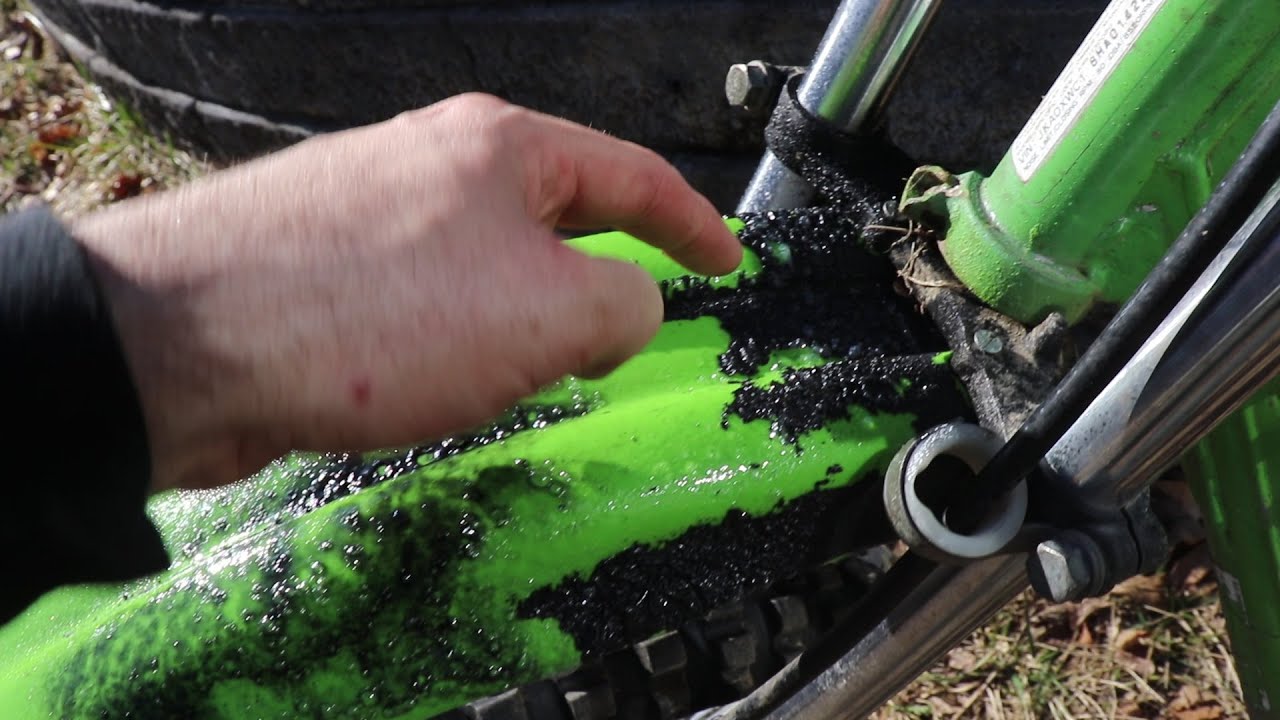When it comes to removing paint from dirt bike plastics, there are a few different methods that you can use. The most common method is using a razor blade or a utility knife. You will want to start by scraping off as much of the paint as you can.
Once you have scraped off as much as you can, you will want to use some sandpaper to remove any remaining paint. If you are careful, you should be able to remove all of the paint without damaging the plastic.
- Scrub the paint with a brush or sponge and soapy water
- Rinse the area with clean water
- Repeat steps 1 and 2 as necessary
- Use a commercial paint stripper if the paint does not come off with soap and water
- Follow the manufacturer’s instructions for use and safety when using this product
How to remove spray paint from dirt bike plastics.
What is the Easiest Way to Remove Paint from Plastic?
Assuming you want to remove paint from plastic without damaging the plastic: There are a few ways to remove paint from plastic, but the easiest way is probably to use nail polish remover.
Simply soak a cotton ball or rag in nail polish remover and scrub at the paint until it starts to come off.
You may need to do this a few times to get all of the paint off.
How Do You Get Paint off Plastic Without Ruining Plastic?
Assuming you’re asking about removing paint from plastic that’s already painted, here are a few methods that might work:
- Use rubbing alcohol. Dab a cotton ball or soft cloth in rubbing alcohol, then rub it over the paint. This will usually cause the paint to peel away from the plastic.
- Try acetone nail polish remover. Soak a cotton ball or cloth in an acetone nail polish remover, then hold it against the paint for a few minutes. The acetone should dissolve the paint so you can wipe it away.
- Use a heat gun or hair dryer. If either of these is available, you can try heating up the paint until it’s soft enough to scrape off with a razor blade or putty knife. Be careful not to melt the plastic underneath, though!
- Scrub with soap and water. Sometimes, just scrubbing vigorously with soap and water can be enough to remove light-colored paints from plastic surfaces.
How Do You Remove Paint From Plastic Motorcycle Tank?
If you’ve ever accidentally gotten paint on your motorcycle tank, you know it can be a pain to remove. If the paint is fresh, you may be able to simply wipe it off with a rag soaked in mineral spirits. If the paint is old and hardened, however, you’ll need to use a little more elbow grease.
Here’s how to remove paint from plastic motorcycle tanks: First, try using mineral spirits or acetone nail polish remover. Saturate a rag with your chosen solvent and rub it over the painted area until the paint comes off.
You may need to repeat this process several times for stubborn areas. If that doesn’t work, you can try sanding the paint off. Use fine-grit sandpaper and sand in small circles until the majority of the paint is removed.
Be careful not to scratch up the plastic too much – you just want to remove the top layer of paint. Once most of the paint is gone, switch to finer grit sandpaper and lightly buff away any remaining residue.
How Do You Get Paint off of Plastic Models?
Assuming you want to remove paint from a plastic model kit: The best way to remove paint from a plastic model is to use a hobby knife or Exacto blade. First, scrape off as much of the paint as possible.
Next, use acetone or nail polish remover on a cotton swab to remove any remaining paint.

How to Remove Paint from Plastic Without Damaging
Paint can be a difficult substance to remove, especially from plastic. If you’re looking to remove paint from plastic without damaging it, there are a few things you can do. One option is to use nail polish remover.
Soak a cotton ball in nail polish remover and apply it to the area with the paint. Allow it to sit for a few minutes before wiping it away with a clean cloth. You may need to repeat this process a few times to get all of the paint off.
Another option is to use rubbing alcohol. Simply apply to rub alcohol directly to the area with the paint and scrub away with a clean cloth until the paint comes off. Again, you may need to repeat this process several times depending on how much paint there is.
If neither of these options works, you can try using WD-40 or another similar product. Spray WD-40 onto the area with the paint and let it sit for a minute or two before wiping it away with a clean cloth. This should help loosen up the paint so that you can easily wipe it away.
No matter which method you choose, be sure to take your time and be gentle so as not to damage the plastic beneath the paint!
Remove Paint from Abs Plastic
Removing paint from ABS plastic can be tricky, but it’s definitely possible with the right tools and techniques. First, you’ll need to gather up some supplies: acetone, a razor blade, sandpaper, and a soft cloth. Start by applying acetone to the area of the ABS plastic that has paint on it.
Let it sit for a few minutes so that the acetone can break down the paint. Then, use the razor blade to scrape off as much of the paint as possible. If there are any stubborn areas, you can sand them lightly with sandpaper.
Finally, wipe away any residual acetone or paint with a soft cloth. And that’s it! With a little patience and elbow grease, you can remove paint from ABS plastic without too much trouble.
Automotive Paint Remover for Plastic
If you’re looking for a safe and effective way to remove paint from plastic, look no further than automotive paint remover for plastic.
This product is specifically designed to remove paint from plastic surfaces, and it does so without damaging the underlying material.
Simply apply the remover to the painted surface, wait a few minutes, and then wipe away the paint with a clean cloth.
Plastic Safe Paint Remover
If you’re looking for a safe, effective paint remover that won’t damage plastic surfaces, look no further than plastic-safe paint remover. This unique formula quickly and easily removes latex and acrylic paints without harming the underlying plastic surface.
It’s perfect for use on items like toys, picture frames, or any other household item that’s been accidentally painted.
Plus, it’s non-toxic and biodegradable, so you can feel good about using it around your home.
Best Paint Remover for Plastic
Paint is one of the most versatile mediums available for artists, crafters, and DIYers alike. It can be used on a variety of surfaces, including wood, metal, glass, ceramic, and plastic. However, when it comes time to remove paint from these surfaces, the process can vary greatly.
To remove paint from plastic, you will need to use a product that is specifically designed for this purpose. There are a number of different products on the market that can be used to remove paint from plastic, so it is important to choose one that is right for your particular project. When choosing a paint remover for plastic, you will want to consider the type of paint that you are trying to remove.
Some products are designed for oil-based paints while others are better suited for water-based paints. You will also want to consider the size of the area that you need to treat. Some products come in small cans which are perfect for small projects while others come in larger containers which are better suited for larger jobs.
Once you have selected the best product for your needs, follow the instructions carefully and always wear gloves and protective eyewear when working with any type of chemical product. With a little patience and elbow grease, you should be able to remove even the most stubborn paint from your plastic surface!
Paint Remover for Flexible Plastic
If you’re looking for a paint remover for flexible plastic, here are a few things to keep in mind. First, you’ll need to find a product that is specifically designed for use on plastic. Many general-purpose paint strippers will damage or even melt flexible plastic, so it’s important to read the labels carefully.
Once you’ve found a suitable product, follow the instructions carefully. Most paint strippers require you to apply them with a brush or cloth and then wait for a period of time before wiping away the softened paint. With flexible plastics, it’s important not to let the stripper dry completely, as this can cause cracking and other damage.
If done correctly, using a paint stripper on flexible plastic can be an effective way to remove old paint and give your project a fresh start. Just be sure to choose the right product and follow the directions carefully!
Will Wd-40 Remove Paint from Plastic
If you’re looking for a way to remove paint from plastic, you might be wondering if WD-40 will do the trick. The short answer is: it depends. WD-40 is a petroleum-based product that can be effective at removing paint from some surfaces, but it’s not always the best option.
On plastics, WD-40 can sometimes remove paint without damaging the underlying material. However, it’s also possible for WD-40 to cause cracks or other damage to plastic surfaces. If you decide to use WD-40 to remove paint from plastic, make sure to test it on an inconspicuous area first.
If there’s any risk of damage, it’s better to find another method.
Paint Remover for Plastic Models
One of the most difficult tasks when building plastic models is removing paint from the surface. Paint removers can be very harsh and damage delicate plastic parts. There are a few ways to remove paint from your model without damaging it.
One way to remove paint is with rubbing alcohol. Rubbing alcohol will not damage the plastic and will remove most types of paint. Another way to remove paint is with a hobby knife.
You can carefully scrape the paint off with the knife without damaging the plastic beneath. If you need to remove stubborn paint, you can try using acetone or nail polish remover. These products are more aggressive and may damage some types of plastic, so test them on a small area first.
You can also try sanding the paint off with fine-grit sandpaper. This method takes longer, but it won’t damage the plastic surface.
Conclusion
If you’re looking to remove paint from dirt bike plastics, there are a few methods you can try. One is to use a heat gun or hair dryer to soften the paint, then scrape it off with a plastic scraper. Another is to use acetone or nail polish remover on a rag to wipe the paint away.
You can also try sanding the paint off with sandpaper, though this will likely damage the plastic beneath. Whichever method you choose, be sure to work in a well-ventilated area and wear gloves and protective eyewear.
